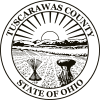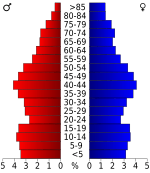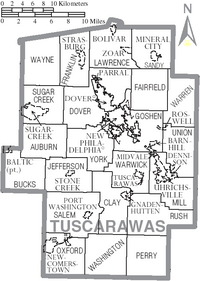Tuscarawas County, Ohio facts for kids
Quick facts for kids
Tuscarawas County
|
|||
|---|---|---|---|
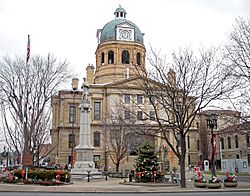
Tuscarawas County Courthouse
|
|||
|
|||
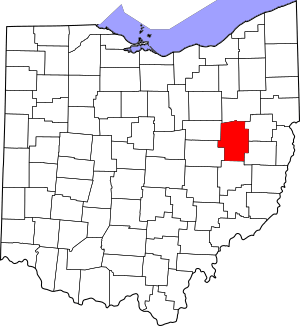
Location within the U.S. state of Ohio
|
|||
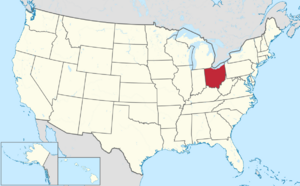 Ohio's location within the U.S. |
|||
| Country | |||
| State | |||
| Founded | March 15, 1808 | ||
| Named for | Delaware Indian word variously translated as "old town" or "open mouth". | ||
| Seat | New Philadelphia | ||
| Largest city | New Philadelphia | ||
| Area | |||
| • Total | 571 sq mi (1,480 km2) | ||
| • Land | 568 sq mi (1,470 km2) | ||
| • Water | 3.8 sq mi (10 km2) 0.7%% | ||
| Population
(2020)
|
|||
| • Total | 93,263 |
||
| • Density | 160/sq mi (60/km2) | ||
| Time zone | UTC−5 (Eastern) | ||
| • Summer (DST) | UTC−4 (EDT) | ||
| Congressional districts | 6th, 12th | ||
Tuscarawas County (/ˌtʌskəˈrɑːwəs/ TUS-kə-RAH-wəs) is a county in the northeastern part of Ohio. In 2020, about 93,263 people lived here. Its main city, or county seat, is New Philadelphia.
The county's name comes from a Delaware Indian word. It can mean "old town" or "open mouth." Tuscarawas County is part of a larger area that includes New Philadelphia and Dover. This area is also part of the bigger Cleveland–Akron–Canton, OH Combined Statistical Area.
Contents
History of Tuscarawas County
For many years, people on the East Coast of America did not know much about the land west of the Appalachian Mountains. Only a few explorers and fur traders had traveled there.
Early Explorations and Missions
In 1750, Christopher Gist explored the Tuscarawas Valley. He reported that the area had natural resources and friendly Native Americans.
In 1761, Moravian missionaries from Bethlehem, Pennsylvania came to set up a mission. Christian Frederick Post, David Zeisberger, and John Heckewelder met with Chief Netawatwees of the western Delaware Indians. The chief invited them to his village, Gekelemukpechunk (now Newcomerstown, Ohio).
He allowed the missionaries to build a cabin near Sandy Creek and the Tuscarawas River. This was in what is now Stark County. They wanted to teach the natives about Christianity. Many people became Christians, but the missionaries had to leave in 1763 during the French and Indian War.
New Settlements and Growing Tensions
Chief Netawatwees asked David Zeisberger to return in 1771. Zeisberger came back to start more missions in the Tuscarawas Valley. In the spring of 1772, near where New Philadelphia, Ohio is today, Zeisberger and five Native American families started the Schoenbrunn mission. Schoenbrunn means "beautiful spring." They built a school and a church. Later that year, John Heckewelder brought 250 more Christian Delaware people to the village.
In late 1772, they started a second village called Gnadenhütten. It was about 10 miles from Schoenbrunn. Gnadenhütten means "cabins of grace." On October 17, 1772, Zeisberger held the first church service there. In 1776, Chief Netawatwes gave land for another village, Lichtenau. This was near Coshocton, which was a main Delaware village at the time.
Impact of the American Revolutionary War
The American Revolutionary War caused these early settlements to end. The Delaware people in eastern Ohio were divided. Some supported the British, and others supported the Americans.
By 1781, Americans thought the Delaware people were helping the British. So, Colonel Daniel Brodhead led American forces from Fort Pitt. On April 19, 1781, they destroyed the village of Coshocton. The people who survived fled north. The American forces left the other Moravian villages alone, but tensions grew.
In September 1781, British forces and their Native American allies, mainly Wyandot and Delaware, forced the Christian Native Americans and missionaries to leave their villages. The Native American allies took their prisoners west to a new village called Captive Town. The British took missionaries David Zeisberger and John Heckewelder to Fort Detroit. They were tried for treason but were found innocent.
The Gnadenhutten Massacre
The people at Captive Town did not have enough food. In February 1782, over 100 people returned to their old Moravian villages. They wanted to harvest crops and get stored food.
In early March 1782, 160 Pennsylvania militia, led by Lieutenant Colonel David Williamson, attacked the villages. They gathered the Native Americans in Gnadenhütten. The militia accused them of raiding Pennsylvania. The Delaware people said they were innocent. However, the militia voted to kill them.
On March 8, the militia tied up the Native Americans. They killed 28 men, 29 women, and 39 children. They then burned the village. They also burned the other abandoned Moravian villages nearby.
This event is known as the Gnadenhutten massacre. It started a frontier war between the Delaware people and the Americans. After several years of fighting, US General "Mad Anthony" Wayne led a campaign in late 1793. This led to the Treaty of Greenville in 1795. This treaty gave the eastern two-thirds of Ohio to white settlers. This opened the land for more settlement.
New Beginnings and County Formation
In October 1798, David Zeisberger returned to the Tuscarawas Valley. He started a new mission called Goshen. He continued his work to teach Christianity to the local natives.
Over the next few years, farmers from Pennsylvania moved into the area. By 1808, the first permanent settlement, New Philadelphia, was founded near the Goshen mission. After the War of 1812, the Goshen mission became less active and closed in 1824.
Tuscarawas County was officially formed from Muskingum County on February 15, 1808.
Geography of Tuscarawas County
The U.S. Census Bureau says the county covers about 571 square miles. Most of this (568 square miles) is land. About 3.8 square miles (0.71%) is water.
Counties Next to Tuscarawas County
- Stark County (north)
- Carroll County (northeast)
- Harrison County (southeast)
- Guernsey County (south)
- Coshocton County (southwest)
- Holmes County (northwest)
Population and People of Tuscarawas County
| Historical population | |||
|---|---|---|---|
| Census | Pop. | %± | |
| 1810 | 3,045 | — | |
| 1820 | 8,328 | 173.5% | |
| 1830 | 14,298 | 71.7% | |
| 1840 | 25,631 | 79.3% | |
| 1850 | 31,761 | 23.9% | |
| 1860 | 32,463 | 2.2% | |
| 1870 | 33,840 | 4.2% | |
| 1880 | 40,198 | 18.8% | |
| 1890 | 46,618 | 16.0% | |
| 1900 | 53,751 | 15.3% | |
| 1910 | 57,035 | 6.1% | |
| 1920 | 63,578 | 11.5% | |
| 1930 | 68,193 | 7.3% | |
| 1940 | 68,816 | 0.9% | |
| 1950 | 70,320 | 2.2% | |
| 1960 | 76,789 | 9.2% | |
| 1970 | 77,211 | 0.5% | |
| 1980 | 84,614 | 9.6% | |
| 1990 | 84,090 | −0.6% | |
| 2000 | 90,914 | 8.1% | |
| 2010 | 92,582 | 1.8% | |
| 2020 | 93,263 | 0.7% | |
| U.S. Decennial Census 1790-1960 1900-1990 1990-2000 2020 |
|||
Population in 2010
In 2010, there were 92,582 people living in Tuscarawas County. There were 36,965 households and 25,318 families. The population density was about 163 people per square mile.
Most people (96.6%) were white. About 0.8% were Black or African American. About 1.9% of the population was Hispanic or Latino.
Many people had German (38.0%), Irish (16.0%), or English (10.9%) backgrounds. Most people (94.7%) spoke English. Some also spoke Spanish (1.4%) or German (1.1%).
The average age in the county was 40.9 years old.
Amish and Mennonite Communities
In 2020, the Amish and Mennonite population in Tuscarawas County was 3,496 people. This was about 3.7% of the total population.
Communities in Tuscarawas County
Cities
- Dover
- New Philadelphia (This is the county seat)
- Uhrichsville
Villages
Townships
- Auburn
- Bucks
- Clay
- Dover
- Fairfield
- Franklin
- Goshen
- Jefferson
- Lawrence
- Mill
- Oxford
- Perry
- Rush
- Salem
- Sandy
- Sugar Creek
- Union
- Warren
- Warwick
- Washington
- Wayne
- York
Census-Designated Places
Other Unincorporated Communities
- Barrs Mills
- Bernice
- Blackband
- Booth
- Brightwood
- Bucks
- Columbia
- Eastport
- Fiat
- Gilmore
- Glasgow
- Goshen
- Hartwood
- Lock Seventeen
- Lowden
- Mount Tabor
- New Cumberland
- Newport
- Peoli
- Postboy
- Ragersville
- Riverside Park
- Rock
- Rockford
- Rush
- Schoenbrunn
- Somerdale
- Stillwater
- Wainwright
- West Chester
- Wilkshire Hills
- Winfield
- Winklepleck Grove
- Wolf
- Yorktown
- Zoarville
Notable People from Tuscarawas County
- Samuel G. Cosgrove, who was the sixth governor of Washington state.
- William Clarke Quantrill, a Confederate guerrilla leader during the American Civil War.
- Cy Young, a famous baseball player in the Major League Baseball Hall of Fame.
- Woody Hayes, a well-known former football coach for Ohio State University.
See also
 In Spanish: Condado de Tuscarawas para niños
In Spanish: Condado de Tuscarawas para niños



